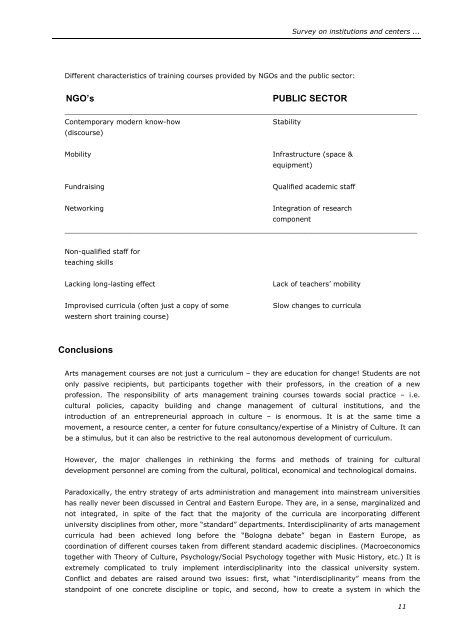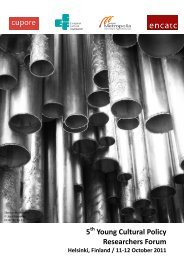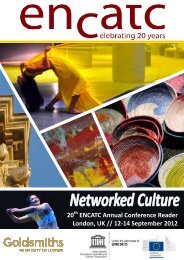- Page 1 and 2: Training in Cultural Policy and Man
- Page 3 and 4: Table of contents Foreword ........
- Page 5 and 6: Université Charles de Gaulle-Lille
- Page 7 and 8: Università degli studi di Palermo
- Page 9 and 10: Switzerland Hochschule für Gestalt
- Page 11 and 12: Foreword Foreword The training of c
- Page 13 and 14: Introduction Drafting of analytical
- Page 15 and 16: PART ONE SITUATION ANALYSIS AND REC
- Page 17 and 18: Survey on institutions and centers
- Page 19: Survey on institutions and centers
- Page 23 and 24: New training needs: Survey on insti
- Page 25 and 26: Survey on institutions and organisa
- Page 27 and 28: Survey on institutions and organisa
- Page 29 and 30: Survey on institutions and organisa
- Page 31 and 32: Survey on institutions and organisa
- Page 33 and 34: Survey on institutions and organisa
- Page 35 and 36: PART TWO PROFILES BY COUNTRY 25
- Page 37 and 38: Number of students admitted No more
- Page 39 and 40: BCC - Bogner Cultural Consulting Kr
- Page 41 and 42: Christian Henner-Fehr Kulturmanagem
- Page 43 and 44: EMA - European Academy of Music The
- Page 45 and 46: ICCM - International Centre for Cul
- Page 47 and 48: Institut für Kulturkonzepte Gumpen
- Page 49 and 50: KulturKontakt Austria Cultural Depa
- Page 51 and 52: Lecturers Profiles: Austria The num
- Page 53 and 54: ÖKS Österreichischer Kultur-Servi
- Page 55 and 56: BSUC - Belarusian State University
- Page 57 and 58: Arts Centre Vooruit (Kunstencentrum
- Page 59 and 60: FMH - Fondation Marcel Hicter 78, R
- Page 61 and 62: Course fee European Diploma in Cult
- Page 63 and 64: POLIS (M.A. in European Urban Cultu
- Page 65 and 66: Vrije Universiteit Brussels PELS PR
- Page 67 and 68: SWU-South West University 'Neofit R
- Page 69 and 70: CDA - Centre for Drama Arts Imagina
- Page 71 and 72:
Profiles: Czech Republic CZECH REPU
- Page 73 and 74:
Tomas Bata University Profiles: Cze
- Page 75 and 76:
Centre for Interdisciplinary Aesthe
- Page 77 and 78:
KaosPilots Mejlgade 35 Århus 8000
- Page 79 and 80:
RMC - Rhythmic Music Conservatory L
- Page 81 and 82:
Royal School of Library and Informa
- Page 83 and 84:
EMA - Estonian Academy of Music Rä
- Page 85 and 86:
Tallinn Pedagogical University Facu
- Page 87 and 88:
Number of students admitted 14 per
- Page 89 and 90:
International/European dimension Pr
- Page 91 and 92:
- Cultural administration; - Market
- Page 93 and 94:
Sibelius Academy P.O.Box 86 / Kutom
- Page 95 and 96:
Sydväst Polytechnic Finnsbacken 4
- Page 97 and 98:
University of Jyväskylä P.O.Box 3
- Page 99 and 100:
University of Vaasa Department of M
- Page 101 and 102:
ENSATT - National School for Perfor
- Page 103 and 104:
Profiles France The main objectives
- Page 105 and 106:
Profiles France I.U.T. Le Havre - I
- Page 107 and 108:
ICOMOS 49-51, rue de la Fédératio
- Page 109 and 110:
Institut d'études européennes de
- Page 111 and 112:
The deadlines for the applications
- Page 113 and 114:
Lille Catholic University Arts and
- Page 115 and 116:
Lumiere Lyon 2 National University
- Page 117 and 118:
Lecturers Profiles France The numbe
- Page 119 and 120:
OPC - Cultural Policies Observatory
- Page 121 and 122:
Paris - Sud University Faculté Jea
- Page 123 and 124:
Number of students admitted The cur
- Page 125 and 126:
Université Stendhal (Grenoble 3) L
- Page 127 and 128:
Universite d'Angers IMIS ESTHUA (Sc
- Page 129 and 130:
Université de Cergy-Pontoise 33 bl
- Page 131 and 132:
Université de Nantes 1, Quai de To
- Page 133 and 134:
Université de Valenciennes et du H
- Page 135 and 136:
Université Paris 12 Faculty of Let
- Page 137 and 138:
Université Paul Valéry-Montpellie
- Page 139 and 140:
Number of students admitted 18 per
- Page 141 and 142:
University of Artois Profiles Franc
- Page 143 and 144:
Entry requirements Profiles France
- Page 145 and 146:
Student profile Students are univer
- Page 147 and 148:
SCF - Stichting Caucasus Foundation
- Page 149 and 150:
Profiles: Germany GERMANY BBW - Aka
- Page 151 and 152:
Berufsfortbildungswerk, Zweigstelle
- Page 153 and 154:
European University Viadrina Facult
- Page 155 and 156:
Fachhochschule Osnabrück Postfach
- Page 157 and 158:
FHK - Kempten University of Applied
- Page 159 and 160:
Special information Profiles: Germa
- Page 161 and 162:
Hochschule für Musik und Theater H
- Page 163 and 164:
Course fee DM 11,- / h + DM 60,- /
- Page 165 and 166:
Lecturers Profiles: Germany The num
- Page 167 and 168:
J.S.W - Institut für Sprachen und
- Page 169 and 170:
KMM - Institute for Arts and Media
- Page 171 and 172:
- Museum documentation; - History o
- Page 173 and 174:
Number of students admitted Continu
- Page 175 and 176:
Pädagogische Hochschule Ludwigsbur
- Page 177 and 178:
SBH - Steibeis University Berlin G
- Page 179 and 180:
Union of Adult Education Wedekindst
- Page 181 and 182:
Evaluation and assessment Profiles:
- Page 183 and 184:
Entry requirements Profiles: German
- Page 185 and 186:
Entry requirements Applicants shoul
- Page 187 and 188:
University of Passau ICUnet.AG Dr.-
- Page 189 and 190:
Verwaltungs- und Wirtschafts-Akadem
- Page 191 and 192:
Course fee EUR 10,123 for 3 years.
- Page 193 and 194:
Entry requirements Profiles: Greece
- Page 195 and 196:
Casus College of Arts and Arts Mana
- Page 197 and 198:
Profiles: Hungary are permanent and
- Page 199 and 200:
Course fee Profiles: Hungary Full t
- Page 201 and 202:
Profiles: Ireland UCD - University
- Page 203 and 204:
ATER - Associazione Teatrale Emilia
- Page 205 and 206:
Profiles: Italy Ceis - Centre for I
- Page 207 and 208:
IULM Libera Università Di Lingue e
- Page 209 and 210:
Evaluation and assessment Profiles:
- Page 211 and 212:
Cultural ManagementL: Applicants sh
- Page 213 and 214:
Course fee None. All of PTA’s cou
- Page 215 and 216:
Università degli studi di Firenze
- Page 217 and 218:
Università degli studi di Roma ”
- Page 219 and 220:
Universitá dell’ Insubria Facolt
- Page 221 and 222:
Latvian Academy of Culture Ludzas s
- Page 223 and 224:
Course fee MA in Cultural Managemen
- Page 225 and 226:
International/European dimension Pr
- Page 227 and 228:
Entry requirements Experience. Cour
- Page 229 and 230:
International/European dimension Pr
- Page 231 and 232:
PAC Multimedia Mihail Cokov 4 Skopj
- Page 233 and 234:
Course fee Profiles Moldova, The Re
- Page 235 and 236:
Amsterdam School of Arts PO BOX 150
- Page 237 and 238:
Course fee Varies. Grants or other
- Page 239 and 240:
Evaluation and assessment Profiles:
- Page 241 and 242:
Utrecht School of the Arts - Interf
- Page 243 and 244:
Telemark University College Hallvar
- Page 245 and 246:
ICC - International Cultural Centre
- Page 247 and 248:
Jagiellonian University Faculty of
- Page 249 and 250:
MISTIA - Malopolska Institute of Lo
- Page 251 and 252:
NCC - National Cultural Centre Depa
- Page 253 and 254:
Profiles: Poland COMMUNITY SERVICE
- Page 255 and 256:
Administration Nacional Institute P
- Page 257 and 258:
INDEG / Business School ISCTE Av. P
- Page 259 and 260:
CTCEMC - Centre for Training, Conti
- Page 261 and 262:
Profiles: Russia RUSSIA Charity Fou
- Page 263 and 264:
Profiles: Russia Programme V -Withi
- Page 265 and 266:
IPC - Institute for Cultural Progra
- Page 267 and 268:
Moscow School of Social and Economi
- Page 269 and 270:
Course fee Fee - not always, but if
- Page 271 and 272:
Entry requirements Profiles: Russia
- Page 273 and 274:
Course fee About 90 percent of the
- Page 275 and 276:
Profiles: Serbia & Montenegro - Inc
- Page 277 and 278:
VSMU - Academy of Music and Dramati
- Page 279 and 280:
CERC - Centre for Cultural Studies
- Page 281 and 282:
ESADE Avda Pedralbes, 60-62 Barcelo
- Page 283 and 284:
Profiles: Sweden The course is aime
- Page 285 and 286:
Universidad Complutense de Madrid F
- Page 287 and 288:
UD - University of Deusto (Bilbao)
- Page 289 and 290:
Profiles: Sweden professionals are
- Page 291 and 292:
UDG - Univesity of Girona The Unesc
- Page 293 and 294:
Universidad de Navarra Centro de Es
- Page 295 and 296:
Course fee 3,164 USD Grants or othe
- Page 297 and 298:
Number of students admitted Superio
- Page 299 and 300:
Södertörn University College Camp
- Page 301 and 302:
Profiles: Sweden Swedish School of
- Page 303 and 304:
Hochschule für Gestaltung und Kuns
- Page 305 and 306:
Trois Cultures Méditerranéennes P
- Page 307 and 308:
Profiles: Switzerland Zertifikatsku
- Page 309 and 310:
Course fee NDS in Cultural Policy a
- Page 311 and 312:
UniWeiterbildung University of Base
- Page 313 and 314:
International Renaissance Foundatio
- Page 315 and 316:
Student profile Students will be un
- Page 317 and 318:
APU - Anglia Polytechnic University
- Page 319 and 320:
Buckinghamshire College Faculty App
- Page 321 and 322:
Chester College of Higher Education
- Page 323 and 324:
City University Arts Policy & Manag
- Page 325 and 326:
Student profile Students are univer
- Page 327 and 328:
Coventry University Priory Street C
- Page 329 and 330:
Programme(s) and qualification(s) P
- Page 331 and 332:
Dartington College of Arts Totnes D
- Page 333 and 334:
De Montfort University Clephan Buil
- Page 335 and 336:
De Montfort University Contact Deta
- Page 337 and 338:
De Montfort University Phone: (0123
- Page 339 and 340:
Edinburgh's Telford College Crewe T
- Page 341 and 342:
EUCLID International 46-48 Mount Pl
- Page 343 and 344:
Goldsmiths College University of Lo
- Page 345 and 346:
Hull University-Scarbourough Campus
- Page 347 and 348:
Student profile At present, student
- Page 349 and 350:
Number of students admitted Profile
- Page 351 and 352:
Leicester University Department of
- Page 353 and 354:
Manchester Metropolitan University
- Page 355 and 356:
Oxford Brookes University Headingto
- Page 357 and 358:
Roehampton Institute Convenor: Paul
- Page 359 and 360:
SBU - South Bank University Divisio
- Page 361 and 362:
School of Performance and Cultural
- Page 363 and 364:
Somerset College of Arts and Techno
- Page 365 and 366:
Thames Valley University The London
- Page 367 and 368:
University of Buckingham United Kin
- Page 369 and 370:
University of Essex Department of A
- Page 371 and 372:
University of Newcastle ICCHS - The
- Page 373 and 374:
University of Northumbria Cultural
- Page 375 and 376:
University of Portsmouth Portland B
- Page 377 and 378:
Course fee £2,940 for UK and EU st
- Page 379 and 380:
Profiles: United Kingdom The aim is
- Page 381 and 382:
University of Surrey Postgraduate S
- Page 383 and 384:
University of Surrey Roehampton Pro
- Page 385 and 386:
Lecturers Profiles: United Kingdom
- Page 387 and 388:
University of Sussex Arts & Cultura
- Page 389 and 390:
University of Warwick Centre for Cu
- Page 391 and 392:
Welsh College of Music and Drama Ca
- Page 393 and 394:
Entry requirements BA (Hons) Leisur
- Page 395 and 396:
International survey carried out by
- Page 397 and 398:
General information Information abo
- Page 399 and 400:
Year of establishment of the instit
- Page 401 and 402:
9. Language(s) teaching 10. Regular
- Page 403:
G. Documents related to your traini






